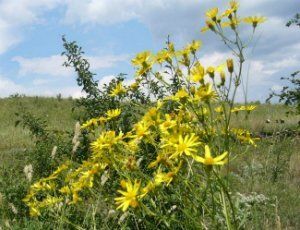Description: Meadowsweet, scientifically known as Filipendula ulmaria, is a perennial herb that belongs to the Rosaceae family. With its graceful appearance and aromatic, frothy clusters of small, creamy-white flowers, Meadowsweet is a common sight in damp meadows, along stream banks, and in other wetland habitats. This plant has been historically valued for its medicinal properties and its pleasant fragrance.
Habitat and Distribution: Meadowsweet thrives in moist to wet soils, often found in meadows, ditches, and alongside rivers and streams. Native to Europe and Western Asia, Meadowsweet has naturalized in various regions globally, including North America. Its adaptability to different moisture levels makes it well-suited to a range of environments.
Physical Features: Leaves: The leaves are pinnately compound, with sharply toothed leaflets that have a serrated edge. They are dark green and provide an elegant backdrop to the flowers.
Flowers: Meadowsweet produces large, frothy clusters of small, creamy-white flowers. The blooms have a sweet fragrance, giving the plant its name.
Ecological Significance: Meadowsweet plays a role in supporting biodiversity by providing nectar and pollen to pollinators, such as bees and butterflies. Additionally, its deep root system helps stabilize soil in wetland areas.
Cultural Uses: Medicinal: Traditionally, Meadowsweet has been used for its medicinal properties. It contains salicylates, which are natural compounds related to aspirin, making it historically used for pain relief and to reduce fever.
Culinary: The flowers and leaves of Meadowsweet are sometimes used to flavor beverages, and the plant has been used in traditional brewing.
Garden and Landscape Plant: Meadowsweet is often cultivated for its ornamental value in gardens and landscapes. Its attractive flowers and foliage contribute to a serene and natural aesthetic, particularly in moist or water garden settings.
Control and Management:
As Meadowsweet is not typically considered an invasive species, control measures are usually unnecessary. However, if its growth needs to be managed in a specific area:
- Pruning: Regular pruning can help maintain the shape and size of Meadowsweet in a garden setting.
- Division: Dividing clumps of Meadowsweet can be done to control its spread and rejuvenate older plants.
- Water Management: Controlling water levels in the surrounding area can influence the growth of Meadowsweet, as it prefers moist to wet conditions.
In conclusion, Meadowsweet is a valuable and visually appealing plant that contributes positively to both natural and cultivated environments. Its cultural uses, ornamental value, and ecological benefits make it a welcome addition to gardens and wetland areas.



